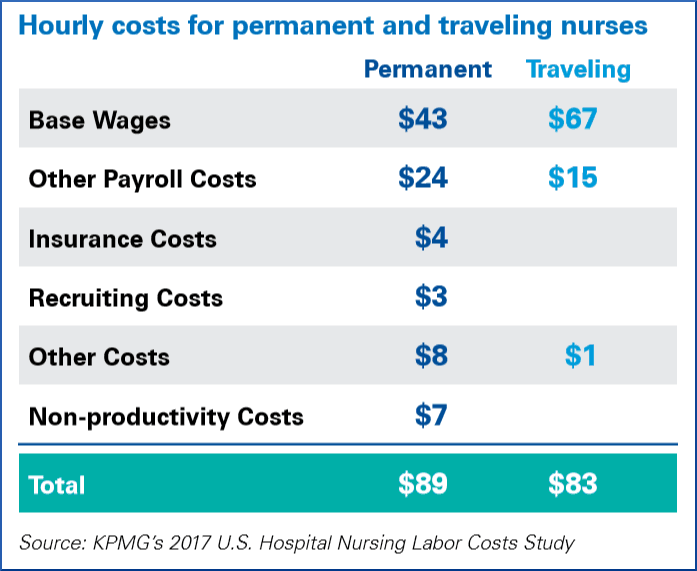What is the Average Bill Rate for a Travel Nurse?
We often see travel nurses ask, “What is the average bill rate for a travel nurse?” In this article, we’ll dissect two reports that provide insight on the average bill rate for travel nurses. We’ll also take a look at how knowing the answer to this question may or may not be useful so you can approach this topic with confidence.
What is a Travel Nurse Bill Rate?
Generally, a “bill rate” is the hourly rate that agencies charge healthcare providers for an hour of the travel nurse’s time. If you’d like to discover more about bill rates, then we recommend the following resources:
- 12 Types of Bill Rates that Affect Travel Nursing Pay
- Podcast covering bill rates
- Travel Nursing Pay: Why Don’t Agencies Divulge the Bill Rate?
Most Cited Sources for Average Travel Nurse Bill Rates
Travelers, agencies and recruiters commonly cite two reports when they discuss the “average bill rate for travel nurses.” The first comes from Staffing Industry Analysts (SIA). The second comes from the National Association of Travel Healthcare Organizations (NATHO).
Unfortunately, both reports are often misunderstood and misrepresented. Let’s take a look at both in detail.
Bill Rate from SIA’s “Travel Nurse Benchmarking Survey”
We’ll start with the report from SIA. In case you’re unaware, SIA is a research and advisory firm focused on the global staffing industry.
Of course, the American Healthcare Staffing Industry is part of the global staffing industry, so SIA covers it with conferences, training, and tons of insightful research. A significant percentage of US healthcare staffing companies subscribe to SIA’s services.
SIA often uses surveys to conduct their research. In 2017, they worked in conjunction with NATHO on their “Travel Nurse Benchmarking Survey.”
Over 21 healthcare staffing companies responded to the survey. According to SIA, the respondents accounted for 68% of the US travel nursing market and $2.9 billion in annual revenue. That’s definitely an adequate sample size.
SIA’s public announcement of the report stated that, “The aggregate bill rate across all respondents was $73.88.” It also stated that the aggregate gross margin was 25.8%.
Many people took this statement to mean that the “average” bill rate for travel nurses is $73.88. This claim quickly spread across social media and various industry related blogs.
Aggregate vs. Average Travel Nursing Bill Rate
Unfortunately, SIA never said the average bill rate for travel nurses is $73.88. Instead, they said the “aggregate” bill rate was $73.88.
Perhaps more importantly, SIA’s public statement didn’t specifically define “travel nurse.” However, they did provide some hints.
So, what’s the big deal? Well, the term “aggregate” means that the data set was comprised of differing items. SIA’s public statement provides 2 indications as to the makeup of the data set.
First, SIA defined the US travel nurse business as travel assignments for RNs, LPNs and Surgical Technicians. Second, SIA indicates that the data set includes “strike business”.
These categories have opposing effects on the “aggregate bill rate.” First, the inclusion of three different modalities (RN, LPN, Surgical Technician) would increase or decrease the average depending on your vantage point.
For example, if you’re an RN, then including LPNs and Surgical Technicians in the calculation skews the average lower for you. If you’re a Surgical Technician or LPN, then including RNs in the calculation skews the average higher for you.
Perhaps more importantly, “strike business” skews the average higher for everyone. Bill rates for strikes are dramatically higher than bill rates for standard travel nursing contracts.
As you can see, this figure, $73.88, is a little ambiguous. It’s certainly not the average bill rate for a standard travel contract for an RN. It’s also not the average bill rate for a standard contract for LPNs or Surgical Technicians.
For us to determine an accurate average bill rate from this report, we would need to be able to separate the aggregate data into its individual parts. Or, at a minimum, we would need to know the percentage of each modality and business-type the report includes in its aggregate figure.
NATHO’s “U.S. Hospital Nursing Labor Costs Study”
The second report that travelers, agencies and recruiters often cite when they discuss the average bill rate for travel nurses comes from NATHO. In 2017, NATHO commissioned KPMG, one of the world’s largest accounting firms, to survey hospital executives about nursing labor costs.
NATHO wanted to compare the cost of permanent staff nurses to the cost of travel nurses. You can download the report here. Unfortunately, the misrepresentation of this report is even worse than it is for the SIA report.
Sample Misrepresentation of the Report
For example, here is a quote referencing the NATHO report. This quote is from a Facebook post that went viral:
There is a real disconnect between what hospital executives are providing in terms of bill rates they are paying travel nurse companies as compared to what recruiters and companies are stating and want you to believe. This survey clearly shows an average bill rate of $83 per hour coming from the people who are actually footing the bill. Time and again we constantly see recruiters spread the falsehood that average bill rates are in the neighborhood of $65/hr to $70/hr. Folks, who are you going to believe??
The author of this quote made a mistake that many others have made and continue to make. The author states that the report “clearly shows an average bill rate of $83 per hour”. This is incorrect. The report does not use the term “average”.
Instead, the report uses the term “all-in cost” per hour. To be fair, the report is very ambiguous in describing what this means. As a result, the report can easily confuse readers into thinking that $83 per hour is the average bill rate.
What NATHO’s Report Actually Sates
To clarify, we’re going to unpack the numbers the report provides. Then, we’ll explain why we think the report conveys the numbers the way it does.
Here is an image of a table from the report.
As you can see, the Traveling column includes figures for Base Wages, Other Payroll Costs and Other Costs. The total is $83 per hour. The report provides a detailed definition for each category.
First, the report states that the hospital’s “Base Rate” is the equivalent of the agency’s bill-rate. Ergo, the hospital executives reported an average bill rate of $67 per hour for the regular hours that travel nurses work.
Next, the report states that “overtime pay” constitutes 100% of the “Other Payroll Costs” for travel nurses. Therefore, hospital executives reported that the average bill rate for overtime hours is $15 higher than the average bill rate for regular hours.
This is in line with what we would expect for overtime bill rates. You can review this article for more information on overtime bill rates for travel nurses.
Finally, the report explains that “Other Costs” include onboarding fees, additional agency fees, completion bonuses and other administrative costs. The total value of these costs is $1 per hour.
Therefore, the real story is that this survey of 100 senior hospital executives found that the average bill rate for travel nurses was $67 per hour for regular hours. Meanwhile, the average overtime bill rate for travel nurses was $82 per hour.
Why Did They Report Travel Nursing Bill Rates This Way?
Essentially, the “all-in cost” is the cost of an overtime hour. But why would the authors of the report do this? Why wouldn’t they clearly convey the cost of a regular hour and the cost of an overtime hour? We can only speculate as to why they reported it this way.
First, this report is designed to help hospital executives realize the cost benefits of utilizing travel nurses. From that perspective, the results of the report simply do not look as good if the costs are separated into regular hours and overtime hours.
For example, the “Other Payroll Costs” for Permanent nurses include $21.50 for overtime. If we take that out, then we are left with $2.50 for Other Payroll Costs. Based on the image above, the Total value for one regular hour for a Permanent nurse would be $67.50.
For travel nurses, we would just need to deduct the full $15 per hour for “Other Payroll Costs”. If we do that, then the Total value for one regular hour for a travel nurse is $68.
As you can see, a regular hour is slightly more expensive for a travel nurse than it is for a permanent staff nurse. We speculate that the report authors did not want to highlight this fact. Essentially, the report looks better if they highlight the overtime hours because the cost savings is so much more pronounced.
It’s interesting to note that report does not claim that travel nurses are less expensive despite the fact that the figures it highlights certainly indicate such. Instead, the report repeatedly uses the phrase, “traveling nurses appear to be a cost-effective solution”.
It would seem as though travel nursing companies use the same slick sales tactics with their hospital clients as they do with their traveling nurses.
The Report’s Actual Bill Rate for Travel Nurses
Interestingly, $67 per hour is in-line with what the Facebook poster claimed that recruiters and agencies routinely cite as the average bill rate for travel nurses. So, is the average bill rate actually $67 per hour? It’s probably in that range, but the report provides some information about the respondents which casts some doubt.
Specifically, the report indicates that 55% of respondents worked for hospitals located in the West or Northeast of the country. As we all know, bill rates are much higher in these regions than they are in the South or Midwest. Therefore, it’s possible that the average is skewed higher.
However, we would also need to know the average percentage of jobs in the West and Northeast versus the South and Midwest. For example, if 70% of all jobs are located in the West and Northeast, then the survey might actually underrepresent these regions. This would skew the average lower.
What is the Average Bill Rate for Travel Nurses?
With all of this in mind, it would seem as though the average bill rate for travel nurses is in fact somewhere between $65 and $73 per hour. But how can we actually use this information?
Consider Additional Variables with the Average Travel Nursing Bill Rate
First, it’s important for travel nurses not to rely exclusively on an average bill rate when they evaluate pay packages. Remember, it’s an average. Many assignments will have higher or lower bill rates.
If you rely only on the average, then you may accept a pay package that is lower than it could be because the package looks higher than average. On the flip side, you might walk away from assignments because you think they are paying lower than the average bill rate would allow.
Instead, it’s important for travel nurses to consider additional variables that influence the value of bill rates. The following variables are examples:
- Specialties: Specialties like Cath Lab, CVICU and PICU are higher. Med Surg, PSYCH, and PEDS are lower.
- Location: California, Washington and New Hampshire are higher. Ohio, Arkansas and Kentucky are lower.
- Need: Hospitals sometimes have a greater need for one reason or another.
- Season: Some regions exhibit higher bill rates in certain seasons.
It Would Help to Know the Range and History
Second, knowing the average would be much more useful if we also knew the range. In other words, what is the lowest bill rate and what is the highest bill rate? Knowing the range would help travel nurses determine where they fit in on the scale.
Similarly, knowing the history of the average bill rate would also be beneficial. If travel nurses had historical information, then they would have a better idea of how much more or less they could expect to earn in the current year versus previous years.
Don’t Count on an Average
Third, travel nurses should not make future salary estimates based on the average bill rate. Many newcomers and experienced travel nurses want to use the average bill rate as a way to determine how much money they can count on making as a travel nurse.
Unfortunately, you may end up taking assignments that pay less or more than the average. Travel nursing pay is notoriously variable. This is one of the downsides, or upsides, to travel nursing.
How Should Travel Nurses Evaluate Pay?
All things considered, it is only slightly useful to know the average bill rate for travel nurses. It can help us determine if a particular assignment pays above or below the average. It can help us categorize regions, specialties and specific hospitals as paying above or below average. That, in and of itself, is slightly useful.
However, it’s still crucial for travel nurses to compare pay packages between agencies and between hospitals. When it comes to agencies, different agencies often pay different rates for the same job.
Most often, there are legitimate reasons that agencies pay different rates. Therefore, the highest paying agency for one assignment may not be the highest paying agency for another.
When it comes to hospitals, different hospitals located in the same city often have dramatically different bill rates. Therefore, you can’t assume that a certain metropolitan area pays low rates based on the pay package from one hospital in the area.
The point is that the “average travel nursing bill rate” represents a broad range of bill rates. In the end, it’s still best for travel nurses to evaluate and compare pay packages on a case by case basis.






